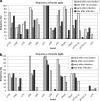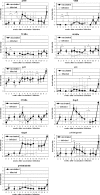Humoral immune response in dogs naturally infected with Borrelia burgdorferi sensu lato and in dogs after immunization with a Borrelia vaccine
- PMID: 20219882
- PMCID: PMC2863390
- DOI: 10.1128/CVI.00427-09
Humoral immune response in dogs naturally infected with Borrelia burgdorferi sensu lato and in dogs after immunization with a Borrelia vaccine
Abstract
Lyme arthritis in dogs can be induced under experimental and natural conditions. However, the veterinary relevance of canine borreliosis is still under extensive investigation. The prevalence of symptoms is clearly low, although the risk of tick exposure is high. Current research focuses on case definitions, methods for diagnosing clinical disease in dogs, and discrimination between an immune response to a natural infection and an immune response to vaccination. In this experimental study, 23 dogs raised under tick-free conditions were allocated to two groups. The 11 dogs in the first group were vaccinated with a commercial borrelia vaccine and subsequently developed detectable antibody titers. The 12 dogs in the second group were walked on two consecutive days in an area where ticks were endemic. On day 5 after exposure, engorged ticks were removed from the 12 dogs and were analyzed for Borrelia DNA by a real-time PCR assay. Blood samples were taken before exposure/vaccination and at defined time points thereafter. Antibody responses were evaluated using an immunofluorescence antibody test (IFAT) and Western blotting. Seven dogs from which Borrelia-positive ticks were removed seroconverted and developed individual immune responses. Blood and urine samples taken from the tick-exposed group at weeks 1 and 3 for real-time PCR analysis and culture were always negative for bacterial DNA. In conclusion, despite serological evidence of infection/immunization, no clinical signs of disease were observed. The antibody patterns in a single Western blot did not permit differentiation between the different antigen sources (vaccine versus natural infection). However, repeated Western blot analyses may be useful for the confirmation of infection or vaccination status, since the time courses of the levels of specific antibodies seem to be different.
Figures





Similar articles
-
Prevalence of DNA and antibodies to Borrelia burgdorferi sensu lato in dogs suspected of borreliosis.Ann Agric Environ Med. 2005;12(2):199-205. Ann Agric Environ Med. 2005. PMID: 16457474
-
Immunization with a recombinant subunit OspA vaccine markedly impacts the rate of newly acquired Borrelia burgdorferi infections in client-owned dogs living in a coastal community in Maine, USA.Parasit Vectors. 2015 Feb 10;8:92. doi: 10.1186/s13071-015-0676-x. Parasit Vectors. 2015. PMID: 25890386 Free PMC article.
-
Antibodies against specific proteins of and immobilizing activity against three strains of Borrelia burgdorferi sensu lato can be found in symptomatic but not in infected asymptomatic dogs.J Clin Microbiol. 2000 Jul;38(7):2611-21. doi: 10.1128/JCM.38.7.2611-2621.2000. J Clin Microbiol. 2000. PMID: 10878052 Free PMC article.
-
Epidemiological studies of Lyme borreliosis and tick-borne encephalitis.Scand J Infect Dis Suppl. 1994;92:1-63. Scand J Infect Dis Suppl. 1994. PMID: 8047853 Review.
-
An update on the serodiagnosis of canine Lyme borreliosis.J Vet Intern Med. 1990 May-Jun;4(3):167-71. doi: 10.1111/j.1939-1676.1990.tb00891.x. J Vet Intern Med. 1990. PMID: 2195165 Review.
Cited by
-
Immunization with a Borrelia burgdorferi BB0172-derived peptide protects mice against lyme disease.PLoS One. 2014 Feb 5;9(2):e88245. doi: 10.1371/journal.pone.0088245. eCollection 2014. PLoS One. 2014. PMID: 24505447 Free PMC article.
-
Wildlife reservoirs for vector-borne canine, feline and zoonotic infections in Austria.Int J Parasitol Parasites Wildl. 2014 Dec 12;4(1):88-96. doi: 10.1016/j.ijppaw.2014.12.001. eCollection 2015 Apr. Int J Parasitol Parasites Wildl. 2014. PMID: 25830102 Free PMC article.
-
Effect of owner-controlled acaricidal treatment on tick infestation and immune response to tick-borne pathogens in naturally infested dogs from Eastern Austria.Parasit Vectors. 2013 Mar 9;6:62. doi: 10.1186/1756-3305-6-62. Parasit Vectors. 2013. PMID: 23497548 Free PMC article.
-
Tick-borne Diseases (Borreliosis, Anaplasmosis, Babesiosis) in German and Austrian Dogs: Status quo and Review of Distribution, Transmission, Clinical Findings, Diagnostics and Prophylaxis.Parasitol Res. 2015 Aug;114 Suppl 1:S19-54. doi: 10.1007/s00436-015-4513-0. Parasitol Res. 2015. PMID: 26152408
-
Lyme borreliosis in Brazil: a critical review on the Baggio-Yoshinari syndrome (Brazilian Lyme-like disease).Clin Microbiol Rev. 2024 Dec 10;37(4):e0009724. doi: 10.1128/cmr.00097-24. Epub 2024 Nov 4. Clin Microbiol Rev. 2024. PMID: 39494872 Review.
References
-
- Barthold, S. W., S. A. Levy, E. Fikrig, L. K. Bockenstedt, and A. L. Smith. 1995. Serologic responses of dogs naturally exposed to or vaccinated against Borrelia burgdorferi infection. J. Am. Vet. Med. Assoc. 207:1435-1440. - PubMed
-
- Bauerfeind, R., U. Kreis, R. Weiss, L. H. Wieler, and G. Baljer. 1998. Detection of Borrelia burgdorferi in urine specimens from dogs by a nested polymerase chain reaction. Zentralbl. Bakteriol. 287:347-361. - PubMed
-
- Blaschitz, M., M. Narodoslavsky-Gföller, M. Kanzler, J. Walochnik, and G. Stanek. 2008. Borrelia burgdorferi sensu lato genospecies in questing Ixodes ricinus in Austria. Int. J. Med. Microbiol. 298(Suppl. 1):168-176.
-
- Bruckbauer, H. R., V. Preac-Mursic, R. Fuchs, and B. Wilske. 1992. Cross-reactive proteins of Borrelia burgdorferi. Eur. J. Clin. Microbiol. Infect. Dis. 11:224-232. - PubMed
Publication types
MeSH terms
Substances
LinkOut - more resources
Full Text Sources
Medical

